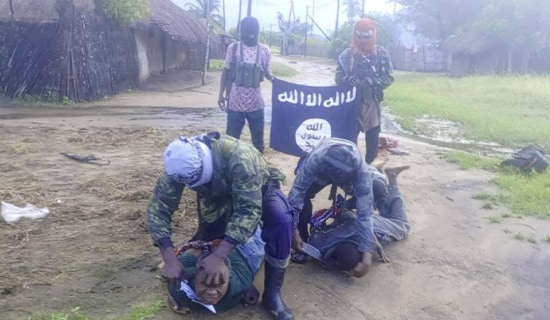China was left alone to wield its economic and military might over weaker nations for years. It bullied its way to pressure others to bend to its will. Its hegemonic ambitions over the Indo-Pacific are no secret.
Taiwan is an integral part of China's ambitions. Not only will a unification with the island nation break the U.S.'s line of defense in the first island chain and extend China's military reach, but it will also accelerate China's capabilities in advance semiconductor manufacturing. Subsuming Taiwan will make China an even stronger economic and military power while wiping out the last vestige of its "Century of Humiliation."
Everything was going China's way until Ferdinand Marcos Jr. was elected president of the Philippines in 2022. Under Marcos' leadership, the Philippines has assumed the role of vanguard for a free and open Indo-Pacific. It is fighting on behalf of all nations who have a stake in the South China Sea. It is bravely standing-up to China's bullying as it defends its sovereign rights in the disputed waters. Marcos firmly aligned the Philippines with the axis of democracy that includes the U.S., Japan, Australia, South Korea, and others.

Balikatan Exercise (Source: X)
Six Ways In Which The Philippine Foils China's Plans
The Philippines is the thorn in China's side as it pursues its hegemonic ambitions in its typical barbaric style. Here are the six ways in which the Philippine has foiled China's plans:
Expanding The Enhanced Defense Cooperation Agreement (EDCA) With The United States
On February 2023, Marcos expanded the Enhanced Defense Cooperation Agreement (EDCA) with the United States. EDCA's expansion granted the U.S. access to nine military bases in strategic areas of the Philippine archipelago.[1]
This negates China's geographical advantage over the U.S. if and when an armed conflict erupts over Taiwan. Without the Philippine base access, the U.S. could only deploy air and sea vessels from faraway Hawaii, Guam, or Okinawa. Now it can do so on a moment's notice. The Philippine Naval Camp Osias in Cagayan is only 364 miles from Taiwan. Camp De la Cruz in Isabela and the La-Lo airport are less than 466 miles away.
Access to Philippine bases give the U.S. logistical capabilities for storage, re-supply, and maintenance operations of its war assets. They effectively serve as a perpetual functioning military base right at Taiwan's backyard.
Further, access to the nine bases allows the U.S. to launch attacks not only on Chinese forces in Taiwan but more significantly directly to the Chinese mainland. Fujian province is only 434 miles away from the northernmost Philippine base.
Reciprocal Access Agreements With Australia And Japan
Apart from granting base access to the U.S., the Philippines has entered into a reciprocal access agreement with Australia and Japan and soon,[2] with France.[3] These agreements help to realize training for inter-operability of naval and air forces, making the allied forces function more cohesively. The Philippines is expected to grant the same privilege to more allies.
Future armed conflicts will be characterized by greater interoperability among likeminded partners, and this means enhanced reciprocal access, greater participation in larger and more complex exercises, and greater investments in advanced capabilities. Manila stands at an intersection of all these.
On-Site Drills And Training
The weather patterns and tidal behavior in the Taiwan Strait are unique. Access to Philippine bases allows the U.S. and its allies to train in the very site of combat. Through the Balikatan Military Exercises, the annual military exercises between the Philippines and the U.S., both countries are able to simulate maneuvers in the very location where they would take place. Balikatan is the largest joint military exercise with more than 16,000 fighters participating including soldiers from Australia and France. Fourteen like-minded countries observed the exercise.[4]
Balikatan 2023 was conducted in the Ilocos Strait, the body of water that separates Taiwan and the Philippines. Balikatan 2024 tested instead the ability to secure a strategic island group only 125 miles away from Taiwan.[5] Mastering the terrain of war was once a Chinese advantage. It no longer is.
U.S. Power Projection In The Indo-Pacific
Formidable U.S. presence in the Philippines allows the U.S. to project power in the Indo-Pacific. It foils China's plan to subsume the West Philippine Sea, parts of northern India, the Senkaku Islands of Japan, and, of course, Taiwan itself. Moreover, the U.S. presence tempers China's strategy of deploying a grey zone toward its weaker adversaries.
Manila's Participation In The Defense Of Taiwan Alongside The U.S. Is Assured
The Philippines will surely be involved in the event that Taiwan is invaded. This is because Manila has more than 200,000 Filipino workers on the island nation, all of whom will need to be evacuated. An evacuation plan is already in place. Moreover, Manila's participation in the defense of Taiwan alongside the U.S. is assured. The Philippines is also in a position to render critical medical and humanitarian support given its large supply of health professionals.
The Philippines has had a long history of accepting refugees in response to humanitarian crises. It did so for the Jews during the holocaust, the Vietnamese during the Vietnam war, the Cambodians during the Khmer Rouge regime, and the Syrians during the Syrian Civil war, among others. Without doubt, the Philippines will do the same for the Taiwanese.
This is a cause for worry for China as it fears Taiwan's talented tech-savvy workforce may slip through the cracks and find their way to Manila. Even if the Chinese impose a blockade to deter an exodus of refugees, such a blockade will likely be equalized by the U.S.
The Philippines Is Among The Fastest Growing Major Economies In The World
The Philippines is among the fastest growing major economies in the world. It is exiting China's Belt and Road initiative this year and pivoting to its trilateral partners, the U.S. and Japan, for economic cooperation. The Philippines' rapid development demonstrates that there is an alternative route outside Beijing's BRI and debt traps. The decision of the Philippines to confront China with bravery, despite the bullying, has tipped the advantage to the United States. This has effectively foiled China's intention to pursue its hegemonic ambitions with impunity.
*Andrew J. Masigan is the MEMRI China Media Studies Project Special Advisor. He is a Manila-based economist, businessman, and political columnist for The Philippine Star. Masigan's articles in MEMRI are also published in The Philippine Star.
[1] Ph.usembassy.gov/enhanced-defense-cooperation-agreement-edca-fact-sheet/
[2] Mofa.go.jp/s_sa/sea2/ph/pageite_000001_00432.html, July 8, 2024; Rappler.com/philippines/view-manila-things-to-know-reciprocal-access-agreement-japan/, July 9, 2024; Aseanwonk.com/p/japan-philippines-reciprocal-access-agreement, July 9, 2024.
[3] Thediplomat.com/2024/04/france-philippines-to-begin-negotiating-reciprocal-access-agreement/, April 26, 2024.
[4] Usni.org/magazines/proceedings/2024/june/balikatan-2024#:~:text=Balikatan%202024%20was%20the%2039th,22%20April%20to%2010%20May.
[5] News.usni.org/2024/05/09/u-s-and-philippine-forces-defend-island-chain-near-taiwan-in-balikatan-2024-exercise, May 9, 2024.





